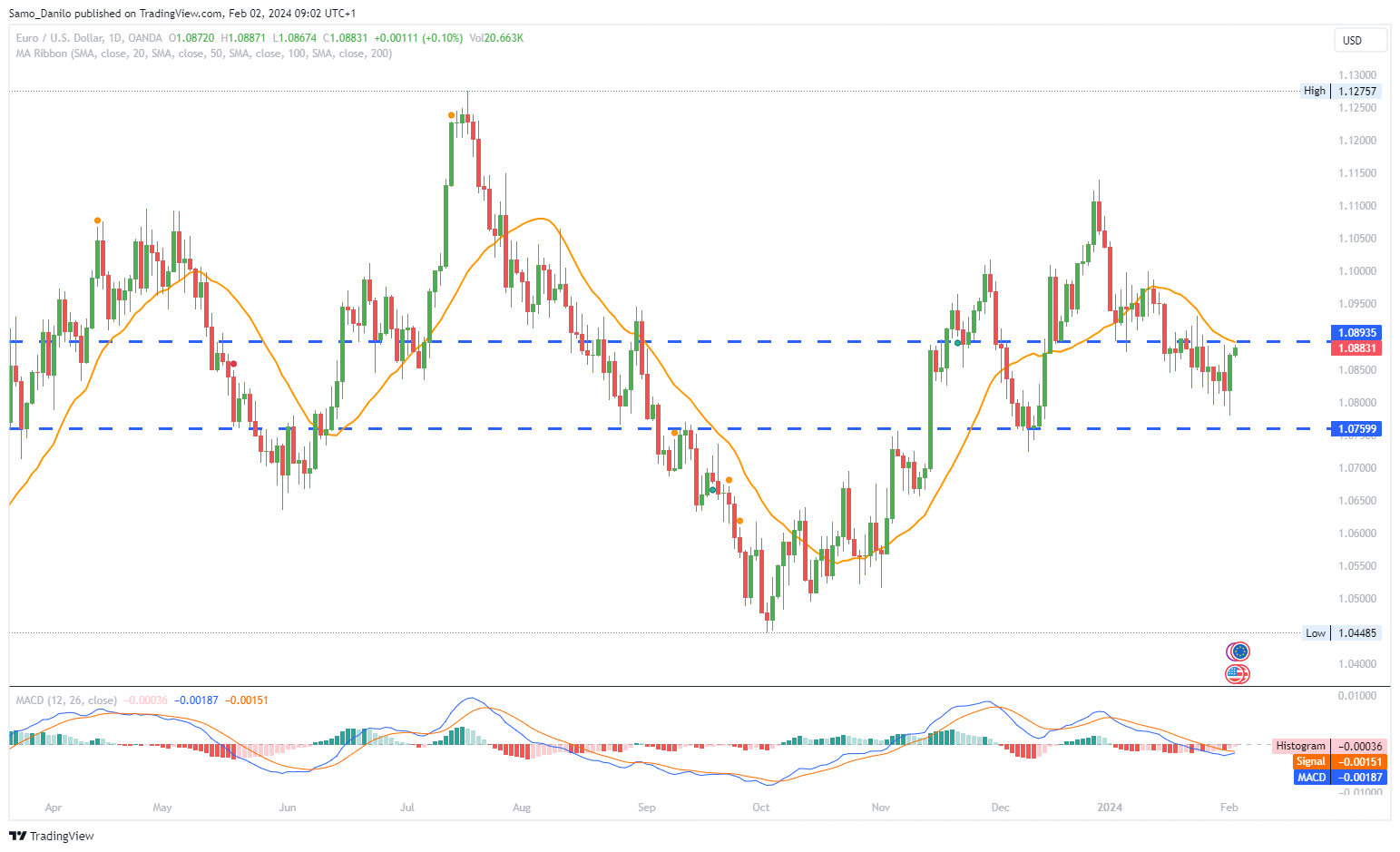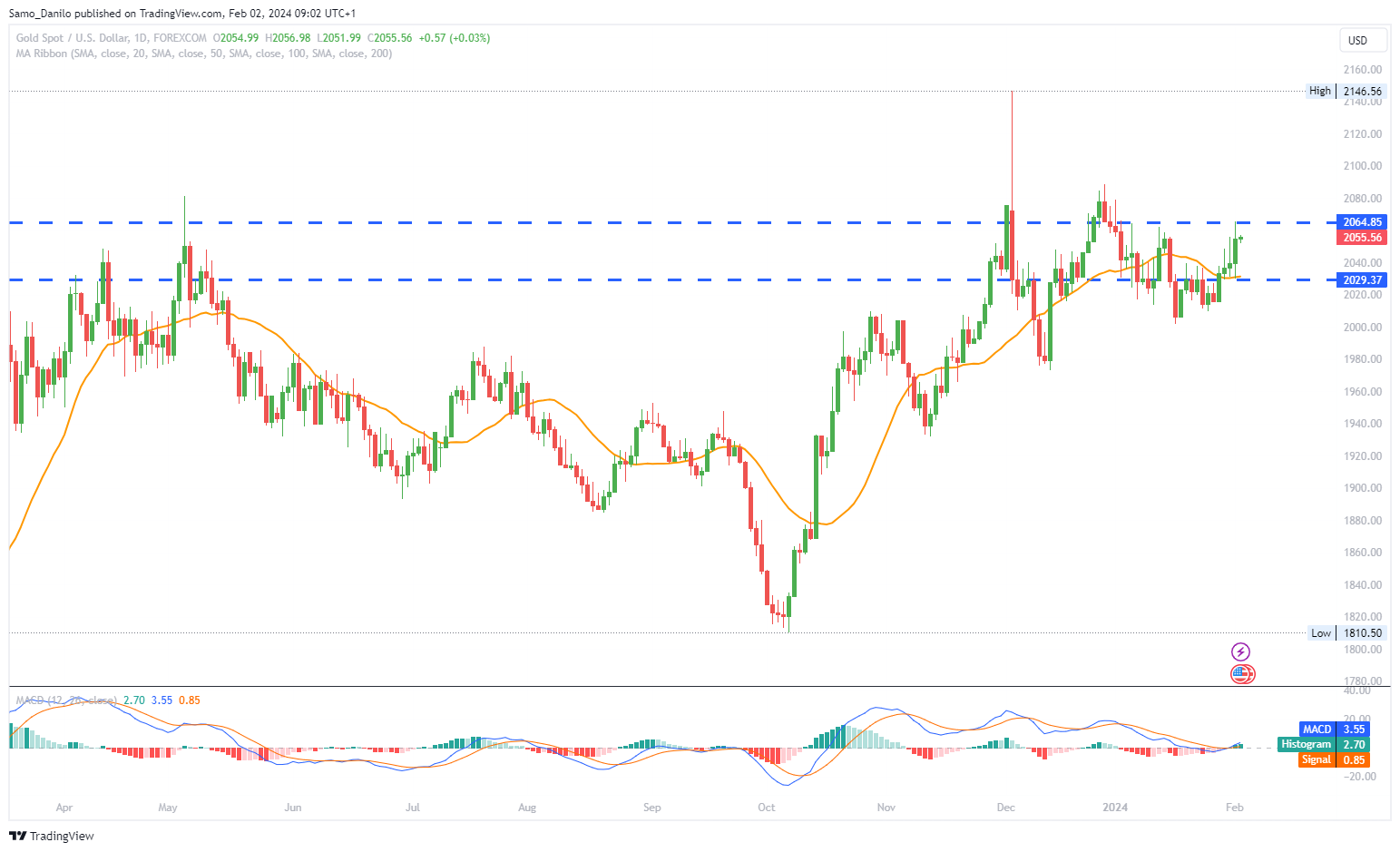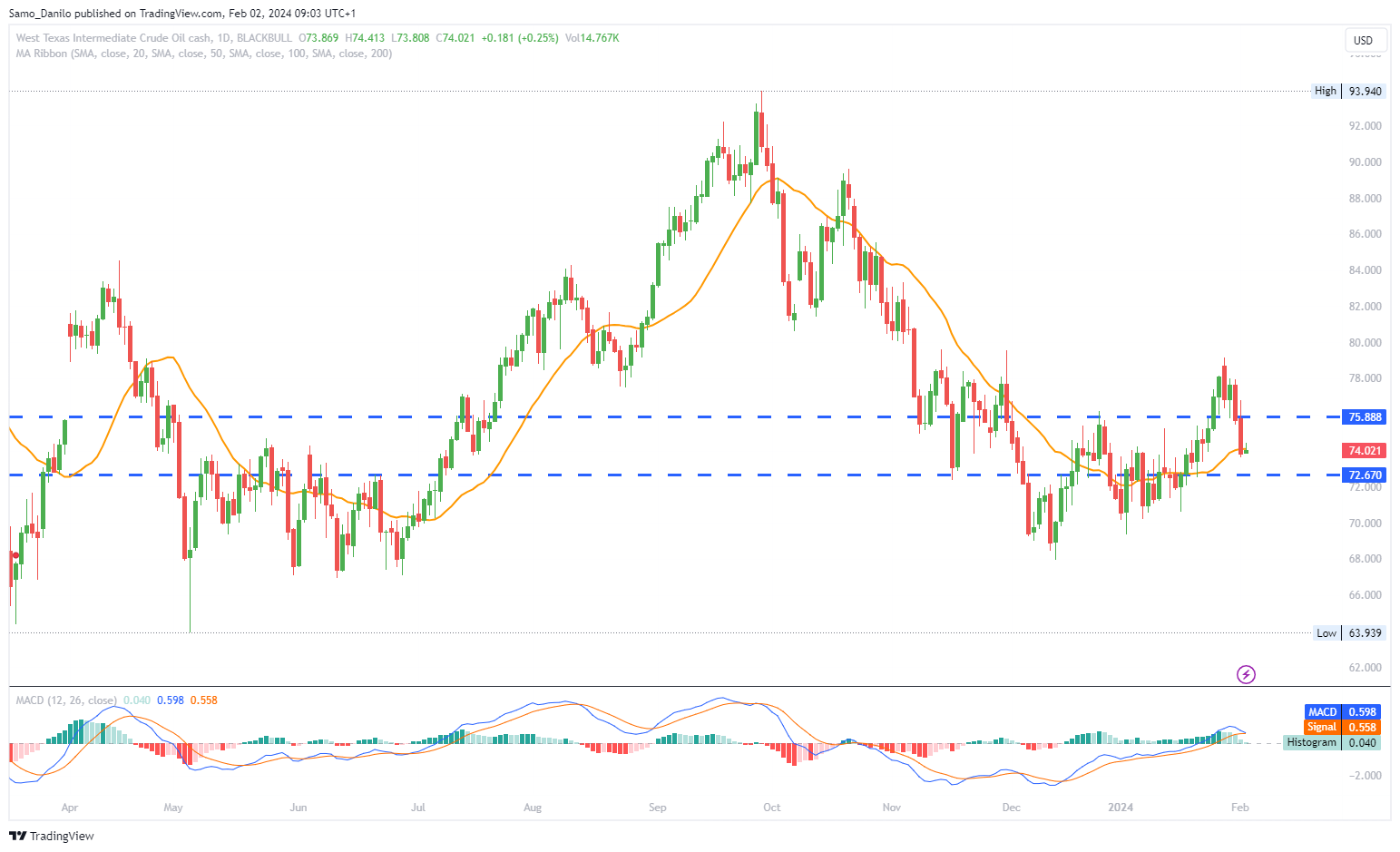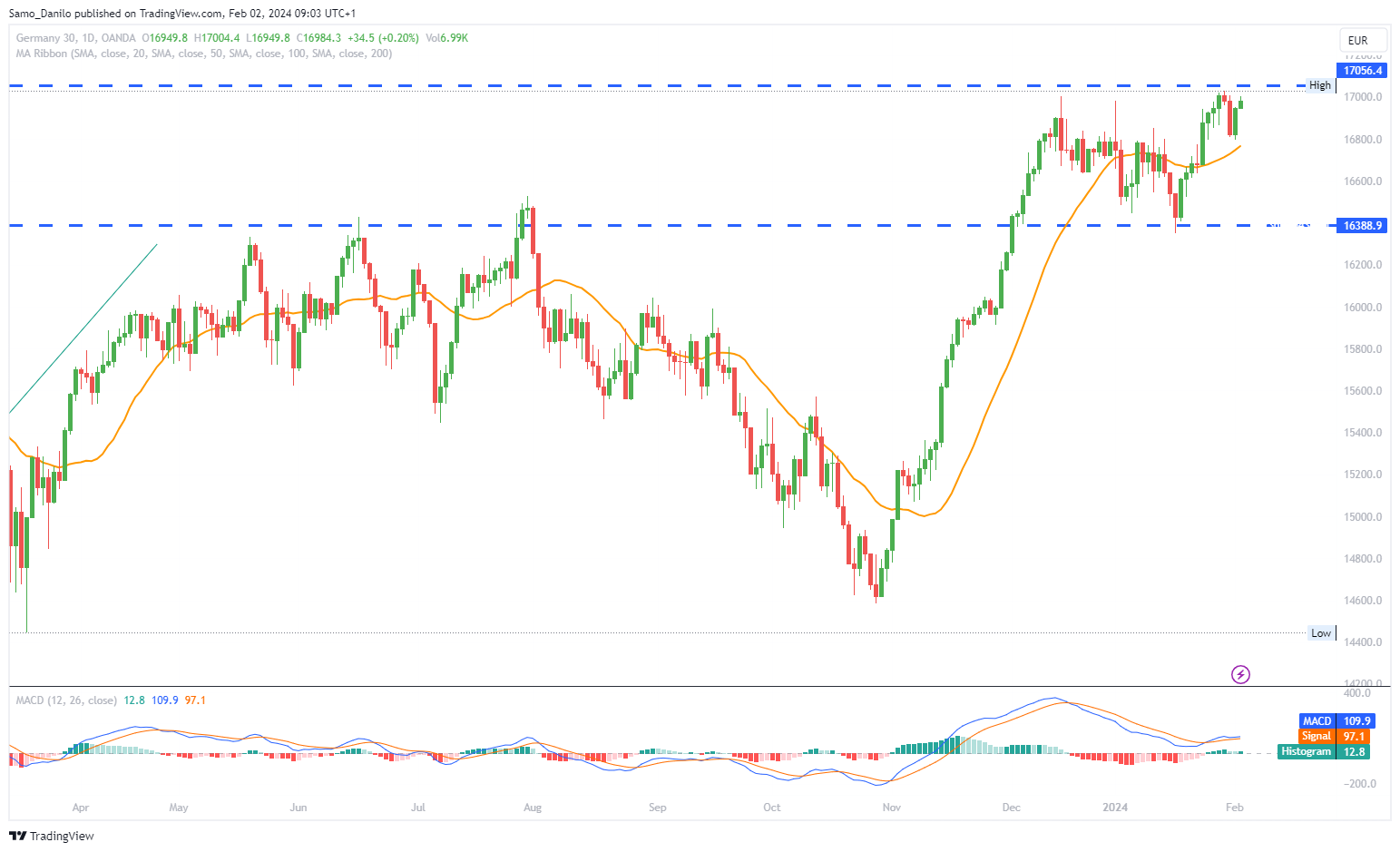EURUSD
- The EUR/USD is showing strength, extending gains toward the 1.0900 level in early European trading on Friday. The recent momentum in the pair is influenced by several factors, including the dynamics of the US dollar and recent statements from Federal Reserve Chair Jerome Powell.
- Powell's remarks have played a significant role in shaping market sentiment. He emphasized that the Federal Reserve is prepared to sustain the current policy rate for an extended period if needed. Powell acknowledged the tightness of the labor market but also highlighted potential adverse impacts on the economy if a policy rate reduction is delayed. The nuanced stance suggests a careful approach to potential rate adjustments.
- Powell's indication that decisions will be made on a meeting-by-meeting basis implies flexibility in the Fed's approach. He expressed the belief that the policy rate has likely reached its peak, signaling a cautious approach to further rate hikes.
- Additionally, Powell suggested that a rate cut in March appeared unlikely based on the current economic conditions.
- Investors are exercising caution, awaiting the release of the significant US Nonfarm Payrolls report scheduled for February 2. This report is a key economic indicator, providing insights into the health of the labor market. The outcome of the report could impact market expectations regarding the timing of future interest rate decisions.
Closing statement: The recent momentum in the EUR/USD is influenced by a combination of factors, including the overall dynamics of the US dollar, Powell's comments on monetary policy, and anticipation of the upcoming Nonfarm Payrolls report.
GBPUSD
- The GBP/USD pair is struggling to capitalize on the solid recovery observed in the previous session, where it gained around 130 pips from the 1.2625 area. The pair is currently oscillating in a narrow band during the early European session on Friday.
- The US Dollar started to gather strength, particularly after Federal Reserve (Fed) Chairman Jerome Powell's statement late on Wednesday. Powell mentioned that he doesn't consider a rate reduction in March as the base case scenario. The prospect of a less dovish Fed stance has contributed to the recent strength in the US Dollar.
- The British Pound (GBP) is finding support from a slightly more hawkish stance adopted by the Bank of England (BoE) on Thursday.
- BoE Governor Andrew Bailey emphasized the need for more evidence that inflation is on track to fall to the 2% target and remain there before considering rate cuts. This stance has added support to the Pound.
- From a technical point of view, the range-bound price action observed since the beginning of the year indicates indecision among traders regarding the next significant directional move in GBP/USD. The pair's behavior in this range suggests that market participants are assessing various factors before committing to a clear trend.
| SMA (20) | Neutral | |
| RSI (14) | Slightly Rising |
|
| MACD (12, 26, 9) | Slightly Falling |
|
Closing statement: GBP/USD is navigating within a narrow range, influenced by the recent strength in the US Dollar following Powell's comments and supported by a slightly more hawkish stance from the Bank of England. Traders are closely monitoring these dynamics and technical patterns for potential insights into the pair's future direction.
GOLD
- Gold price is currently oscillating within a narrow trading band during the European session on Friday. The precious metal is consolidating its weekly gains, having reached a one-month peak in the previous session.
- Gold traders are bracing for a potential volatility spike, particularly in anticipation of the release of critical US labor market data. The Non-Farm Payrolls (NFP) figure for January is expected to come in at 180K, with Average Hourly Earnings projected to rise at an annual pace of 4.1% for the same period. The release of this data is likely to influence gold prices.
- The gold price is on track to its best week in seven, particularly after posting a solid rally on Thursday. The rally on Thursday contributed to the weekly gains and positioned gold as a focal point for investors.
- The US Dollar reversed its gains and experienced a significant decline after the US Labor Department reported that Initial Jobless Claims rose more than expected in the previous week. This decline in the US Dollar has contributed to the strength of gold prices.
- Heading into the US NFP release, markets are pricing in a 39% chance that the Federal Reserve will cut interest rates in March. The probability of a rate cut in May stands at about 85%, indicating expectations of a dovish Fed stance in the coming months.
| SMA (20) | Slightly Falling |
|
| RSI (14) | Slightly Rising |
|
| MACD (12, 26, 9) | Slightly Rising |
|
Closing statement: Gold prices are influenced by a combination of global economic policies, geopolitical events, and economic indicators. The current positive momentum is shaped by announcements from China, the Fed's decision, and anticipation of upcoming economic data.
CRUDE OIL
- WTI crude oil prices experienced a retreat from an early spike to $79.00, falling back to around $74.00 per barrel on Thursday. This movement indicates market participants are closely watching for signals about the global crude oil supply in response to rising global demand.
- Progress on a ceasefire negotiation between Israel and Hamas in Qatar has energy prices leaning into the softer side as markets head into the today’s market session.
- The crude oil markets appeared to shrug off the hawkish stance of the Federal Reserve on Wednesday. The Federal Reserve's statements, which indicated a reluctance to entertain early rate cuts, did not significantly influence crude oil prices.
- OPEC (Organization of the Petroleum Exporting Countries) is making efforts to stabilize and support global crude oil prices. This involves managing production levels, especially in response to the significant output from the United States.
- The economic situation in Saudi Arabia is mentioned, noting a decline of 0.9% YoY in the country's economy. The fourth-quarter Gross Domestic Product (GDP) reportedly decreased by 3.7% compared to the same period last year. The decline is attributed to the impact of reduced activity in the crude oil sector, which contributes substantially to Saudi Arabia's GDP.
| SMA (20) | Slightly Rising |
|
| RSI (14) | Slightly Falling |
|
| MACD (12, 26, 9) | Slightly Rising |
|
Closing statement: The movement in WTI crude oil prices is influenced by a combination of factors, including global supply and demand dynamics, the stance of the Federal Reserve, OPEC's efforts to manage production, and the economic situation in major oil-producing countries like Saudi Arabia.
DAX
- The German Manufacturing Purchasing Managers' Index (PMI) increased from 43.3 to 45.5 in January. This is a positive sign, indicating an improvement in manufacturing activity in Germany. The preliminary figure was 45.4, and the final reading exceeded this estimate.
- The Eurozone's annual inflation rate softened from 2.9% to 2.8%. However, the core inflation rate, which excludes volatile items, eased from 3.4% to 3.3%. The core inflation rate staying relatively high suggests that inflation remains somewhat sticky, which could influence monetary policy considerations.
- On Thursday, despite weaker-than-expected US labor market data, there was no significant impact on buyer demand for DAX-listed stocks. It mentions that bets on a March Fed rate cut remained subdued, indicating the resilience or lack of strong reaction in the market to the economic data.
- On Friday, investors are advised to consider corporate earnings reports from Europe. UniCredit is specifically mentioned on the calendar to release earnings. Corporate earnings reports can significantly influence stock market sentiment.
- The report highlights the importance of monitoring commentary from the European Central Bank (ECB). The reaction to recent inflation figures could impact market sentiment. Central bank communication, especially regarding inflation and interest rates, often plays a crucial role in shaping investor expectations.
| SMA (20) | Slightly Rising |
|
| RSI (14) | Slightly Falling |
|
| MACD (12, 26, 9) | Slightly Rising |
|
Closing statement: In summary, the DAX's performance is influenced by a mix of domestic and global factors, including manufacturing data, inflation rates, US economic indicators, corporate earnings reports, and central bank commentary.




